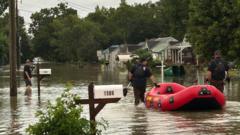What Happened in Tennessee Floods: Three Dead and One Missing?

Understanding the Impact of Recent Flooding in Tennessee
The recent heavy rains and flash flooding in Tennessee have had devastating consequences, claiming the lives of at least three individuals and leaving one person missing. The incidents, which occurred primarily in East Ridge near Chattanooga, highlight the severity of weather-related disasters and the importance of emergency preparedness and response. Local officials have been working tirelessly to manage the situation, but the relentless rains have created challenges that are difficult to overcome.
The Tragic Events Unfolding in East Ridge
On Wednesday morning, a tragic event unfolded when a tree fell on a car, resulting in the deaths of two adults and one child. This incident serves as a grim reminder of the dangers associated with severe weather conditions. The Hamilton County Office of Emergency Management and Homeland Security confirmed the fatalities and reported that the search is ongoing for an individual who was swept away by the floodwaters. The community is rallying together, hoping for a positive outcome in the search efforts.
Ongoing Search and Rescue Efforts
As emergency responders continue their search for the missing person, they face significant challenges posed by the ongoing flash flooding. The local fire department has been active, rescuing residents trapped in flooded vehicles and homes. In one notable incident, firefighters assisted six individuals who were stranded in a van as water levels rapidly rose from an overflowing creek. This highlights not only the immediate danger posed by flooding but also the heroic efforts of first responders during such crises.
Understanding Flash Flood Warnings
Flash floods can occur with little to no warning, often as a result of intense rainfall overwhelming drainage systems. In Tennessee, flash flood warnings are currently in effect for many areas, including Knoxville. These warnings indicate that dangerous conditions are present and that immediate action may be necessary to ensure safety.
What to Do During a Flash Flood Warning
Knowing how to respond during a flash flood warning can save lives. Here are some important steps to take:
- Move to higher ground immediately.
- Avoid walking or driving through floodwaters.
- Stay informed through local news and weather updates.
- Have an emergency kit ready, including food, water, and medical supplies.
- Follow evacuation orders from local authorities.
The Historical Context of Rainfall in Chattanooga
Chattanooga recently experienced one of its wettest days on record, with 6.42 inches of rain falling in just 24 hours. This event marked the second wettest day in the city's recorded history, which dates back to 1879. Such significant rainfall can lead to rapid flooding, as the ground becomes saturated and unable to absorb additional water. Understanding these historical patterns can help communities better prepare for future weather-related challenges.
Climate Change and Extreme Weather
The increasing frequency of extreme weather events raises questions about the role of climate change. Warmer temperatures can lead to more intense rainfall, contributing to flash floods. Scientists and meteorologists are studying these trends to understand how best to prepare for and respond to future events. Communities like Chattanooga must adapt to these changes, implementing strategies to mitigate flooding risks and enhance resilience.
The Role of Local Government and Emergency Services
In response to the recent flooding, Hamilton County Mayor Weston Wamp declared a local state of emergency, allowing for the mobilization of resources and support for affected residents. Local government plays a crucial role in disaster response, coordinating efforts between various agencies and providing assistance to those in need. Effective communication and planning are essential components of a successful emergency management strategy.
Community Support and Recovery Efforts
Community support is vital in the aftermath of a disaster. Local organizations and volunteers often step up to provide aid, whether through food and shelter or emotional support. Recovery efforts can take time, and it is essential for residents to have access to the resources they need to rebuild their lives. Community resilience is built through collaboration and support networks that can help individuals and families navigate the recovery process.
Preparing for Future Flooding Events
As Tennessee continues to grapple with the aftermath of these floods, the focus will also need to shift toward future preparedness. This includes investing in infrastructure improvements, such as better drainage systems and flood control measures, as well as community education on emergency preparedness. Individuals should also take personal responsibility for their safety by understanding the risks and creating family emergency plans.
Creating an Emergency Plan
An effective emergency plan can make all the difference during a crisis. Here are some key components to include in your family’s emergency plan:
- Communication plan: Establish how family members will contact each other during an emergency.
- Evacuation routes: Know the safest routes out of your neighborhood and community.
- Emergency kit: Assemble a kit with essential supplies, including food, water, medicine, and important documents.
- Stay informed: Sign up for local alerts and weather notifications.
FAQs About Flash Flooding
What causes flash flooding?
Flash flooding primarily occurs due to intense rainfall that overwhelms drainage systems and saturates the ground, leading to rapid water accumulation in low-lying areas.
How can I stay safe during a flash flood?
To stay safe during a flash flood, move to higher ground, avoid flooded areas, and stay informed about weather conditions through local news and alerts.
What should I include in an emergency kit for floods?
An emergency kit for floods should include at least three days' worth of non-perishable food, water, a flashlight, batteries, a first-aid kit, and important documents.
Conclusion: Reflecting on Community Resilience
The recent flooding in Tennessee has underscored the importance of community resilience and the need for effective emergency preparedness. As residents come together to support one another, the lessons learned from this disaster will help shape future responses to weather-related events. It is critical for individuals, families, and communities to remain vigilant and proactive in their efforts to mitigate the impacts of flooding. What steps will you take to prepare for potential flooding in your area? #TennesseeFloods #EmergencyPreparedness #CommunityResilience
Published: 2025-08-13 16:00:31 | Category: wales



